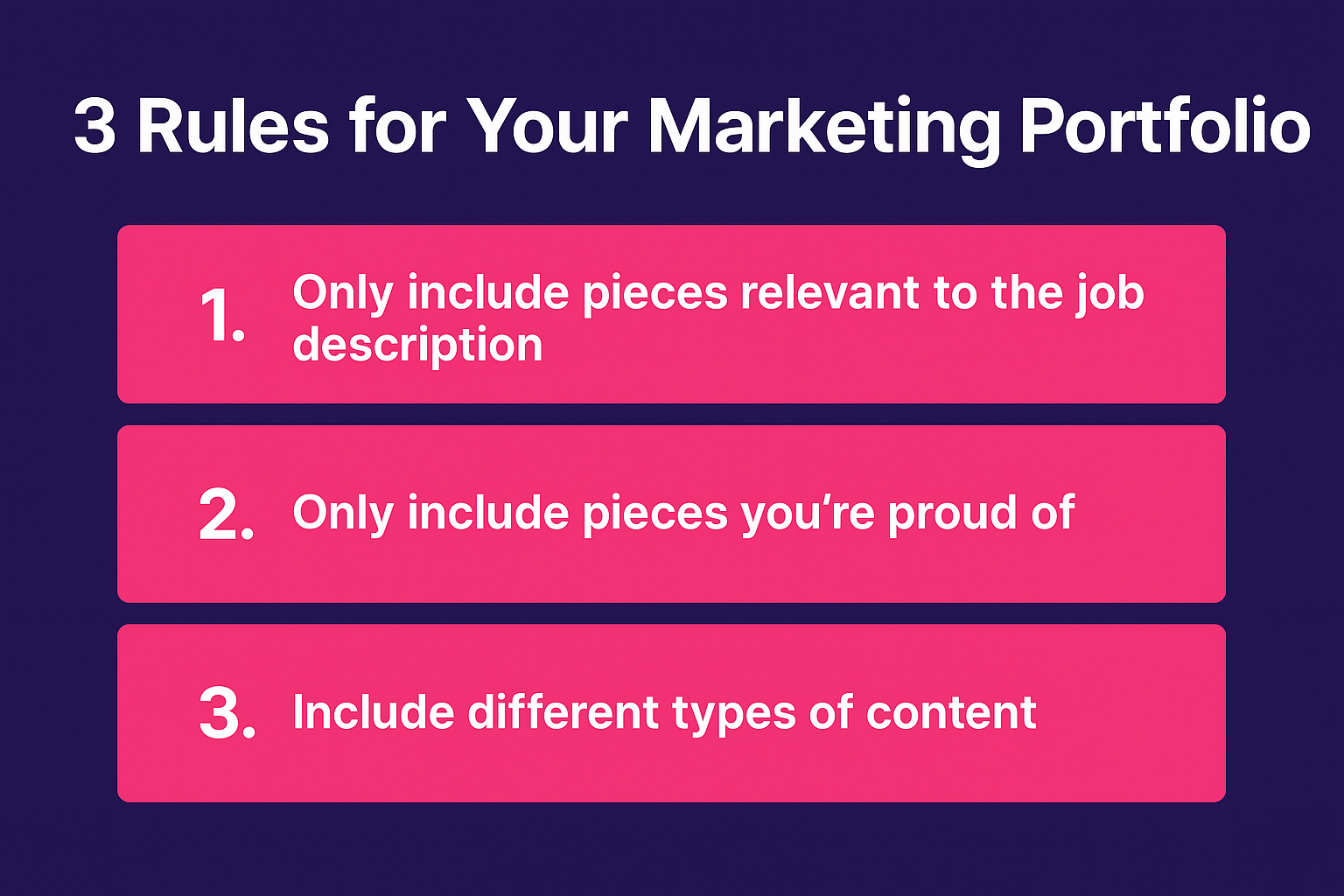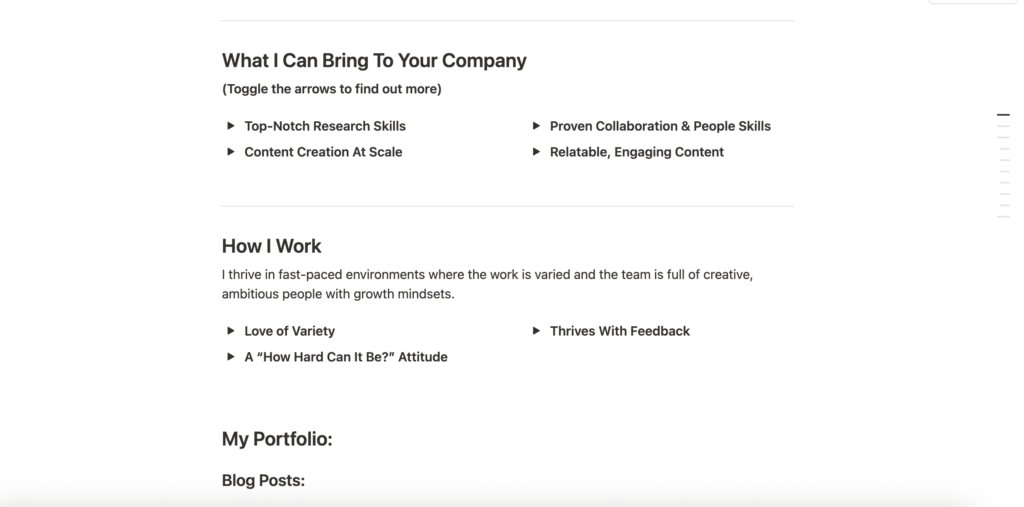How To Create A Marketing Portfolio From Scratch
Building a marketing portfolio from scratch, especially when you don’t have much experience yet, can feel overwhelming. Where do you even start?
The truth is, a marketing portfolio isn’t just a place to show off finished content. It’s your chance to demonstrate how you think, how you solve problems, and how you’d approach real-world marketing challenges. A well-crafted portfolio doesn’t just say “I can do the work”—it shows how you do it, why you make the decisions you do, and what kind of marketer you’re becoming.
In this post, you’ll learn how to create a portfolio that doesn’t rely on big-name clients or published pieces. Instead, we’ll cover how to:
- Choose the right content to include
- Document your growth and projects
- And demonstrate your strategic thinking through smart evaluations.
Keep reading to learn how to create a portfolio that stands out.

What to include in your portfolio
There are some general guidelines that every marketing portfolio should follow, outside of its contents:

1. Only include pieces relevant to the job description
This might seem like a major hurdle if you have absolutely no portfolio pieces, but don’t despair.
If you want to put together a portfolio that you can reuse, the first thing you should do is get super clear on the industry you’re targeting.
Applying to every single marketing job you see isn’t a good strategy, plus it’ll be a lot more work when it’s time to submit work samples.
Before you start creating samples, take a look at job descriptions in your industry and see what type of content they want you to create.
Also consider what type of marketing job you want.
Then it’ll be time to create relevant samples.
2. Only include pieces you’re proud of
Look, we all create lackluster content sometimes. If you’re just starting out, you’ll probably have a lot of bad first drafts in your Google Docs.
So, take stock of what’s genuinely good content. Ask yourself whether this is a good representation of your skills and something you’d be proud to have a hiring manager see.
Remember that it’s totally ok to not write an amazing first draft, or to need to write some practice pieces before you write ones you’re ready to share.
3. Include different types of content
You might be really good at writing particular types of content, like blog posts or social media content, but to show off your skills, including multiple content types is a must.
This doesn’t have to mean creating new content from scratch every time.
My personal favorite strategy is to start with a long piece of content like a blog post, then create social media posts, emails, and video scripts based on the blog post content.
This is referred to as content repurposing and will also be a big help in a marketing job when you have to promote content on different channels.
Do you need published pieces?
A big stressor for a lot of new marketers, especially writers, is whether they need to have pieces published on industry websites to get a job.
In my experience, it’s not always necessary. I’ve gotten passed to the next interview stage after a portfolio review even though I have very few bylined pieces.
I’ve rarely seen jobs that specifically require published pieces, but it doesn’t hurt to write guest posts on industry blogs.
This is also mostly related to writing jobs, so it might not matter at all for the marketing role you’re going after.

What to include in your marketing portfolio: the basics
While every marketing portfolio is different, there’s some basic information you should always include:
Your bio
Don’t let potential employers or clients forget who you are. Write something about yourself that hasn’t already been covered in your resume.
Projects & explanation of projects
Explanations of your projects is extra important when you’re starting out. If you’re creating mock content for a real or fake brand, this is where you can note it. You can also talk about why you chose the brands you did and how it relates to your overall career goals.

Testimonials/letters of recommendation
Don’t just toot your own horn; let others do it for you. Not every job asks for references up front, so if you can put positive reviews of your work in your portfolio, do it.
Results from projects
This isn’t 100% essential, so don’t freak out if you don’t have impressive results yet. But, if you do have some results, share them! You can also use this section to talk about what you’d do to grow more to showcase your understanding of strategy.

Work overview
This is something I’ve started doing in all my job applications.
Your work overview is the place to talk about how you work, as well as reiterate what you’re looking for in your next role. Even if you include a cover letter, including a work overview is great to cement a hiring manager’s impression of you and give more insight about how hiring you can benefit their company.
Here’s an example of what I include in the “work overview” section of my portfolio:

How to make your portfolio stand out
There are 3 main ways to make your portfolio stand out, even if you don’t have marketing experience.
The biggest ways to make your portfolio stand with professional marketers and outshine other newbies is to include content, documentation, and evaluation.
Content
Obviously, every portfolio needs content, whether that’s written, image-based, or video.
Not sure what type of content to include?
Look at the job description.
Some common types of content are:
Written
- Blog posts
- Case studies
- LinkedIn posts
- X posts
- Thought leadership
- Customer stories
- Sales enablement materials
- Brochures
- Newsletters/email marketing
Visual:
- Infographics
- Images for social media
- Reels
- TikToks
- YouTube/long-form videos
- Educational carousels (think LinkedIn)
- Image carousels
If you want to showcase your knowledge of how these all go together, starting a blog is an excellent place to start.
With a blog, you can showcase written content, social media content, long-form videos, email marketing, and more. A blog can demonstrate your knowledge of marketing as a whole. If you can explain why you made the choices you did with your blog’s content strategy and connect it to how you’d do it in a professional setting, that is extremely valuable.
Documentation
Here’s an unfortunate truth: almost every job application for a marketing role is going to ask for your LinkedIn profile. So, you have to make sure your LinkedIn profile is active and shows your expertise.
Posting on LinkedIn as a career changer or recent grad can be intimidating, but you don’t have to post completely original thoughts all the time.
LinkedIn is a great place to document your work. Not only will posting about your projects on LinkedIn keep you accountable for completing them, it’ll show your thought process to potential employers and show you’re interested in the field.
You can also post about certifications you’ve received, plus what you learned from each one. Most people stay basic and just post the certificate, but you’ll stand out if you talk more about your experience and how you’ll apply your learnings to future roles.
Evaluations
Finally, you can show your strategic thinking by evaluating the marketing strategies, materials, etc. of real companies.
You can use marketing analytics tools to analyze what’s working and what’s not in their strategies, and give examples of how you’d adjust. This will also demonstrate your knowledge about those tools.
If you’re a writer, you can rewrite website copy and explain why you made those changes.
Additionally, you can use websites like Marketing Examples to give your take on why a campaign or tactic works. You can also use this to connect back to a specific company’s strategy.

I would recommend keeping this to your private portfolio so the companies don’t see it (with the exception of sharing your take on an already-completed campaign as described above) and won’t steal it.
Bringing it all together
You don’t need years of experience to create a marketing portfolio that stands out—you just need intention, creativity, and a willingness to show your process.
Whether you’re writing blog posts, analyzing campaigns, or documenting your journey on LinkedIn, each piece is a chance to tell a story about how you think and work as a marketer.
The more you can connect your work to strategy, audience needs, and real business outcomes, the more compelling your portfolio becomes.
Start with what you know, build from there, and keep refining. Your portfolio doesn’t have to be perfect; it just has to reflect you and the marketer you’re becoming.
